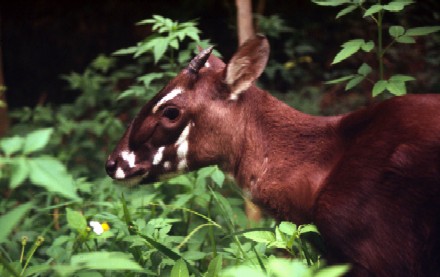Tailor Made Holidays with our travel experts
We'll do our best to call you within 48h

The Western Nghe An Biosphere Reserve with Pu Mat National Park as its centre was recognized as a World Biosphere Reserve by UNESCO in September 2007. It is the sixth biosphere reserve in Vietnam recognized by UNESCO. With an area of 1,303,285m2 the reserve is the largest in Southeast Asia.
Pu Mat National Park is located in the middle of the Annamite, covers three districts - Anh Son, Con Cuong and Tuong Duong – with an area of over 91,000 hectares.
Pu Mat, home to diverse flora and fauna, has 896 flora species, 241 mammal species, 137 bird species, 25 reptiles and 15 amphibians. Many scientists also see Pu Mat as Vietnam’s great museum of animal gene pool.
According to scientists’ research Pu Mat National Park has four species of endemic animals in Indochina. They include the Sao la (Pseudoryx Nghetinhensis), Annamite striped rabbit (Nesolagus spp.nov.), white-cheeked gibbon (Hylobates leucogenys) and yellow-cheeked black gibbon (Hylobates gabriellae). There are also the giant Muntjac, Truong Son Muntjac, red-shanked douc, tigers, elephants, striped civets, Malaysian bears, tibetian bears, crested arguses and bulls.
Coming to visit Pu Mat National Park, tourists will have an opportunity to take part in many fascinating activities: pleasure-boat on Giang River, cool bath, recreations at Kem Waterfall, trade village of brocades and enjoy the other things: bamboo-tube rice and Lam dance…
Pu Mat National Park has 1,841m-high Pu Mat Mountain which is dubbed as the second Fansipan in Vietnam. Visitors to the park are very interested in the wildness of the primeval forests and beautiful landscapes. There is the Kem Waterfall, 150m high, which looks like a white silk band. Its water runs all year round, spreading a spray against the heat of the southwestern wind, relieving the typical scorching weather of the central region in summer. The Moc Spring with clear water is cool in summer and warm in winter, so it is very attractive to visitors.
Coming to this area, visitors can take a boat ride upstream on the Giang River to discover the splendid and superb beauty of the mountains and forests. They can also walk in the forests of Sang le trees (Lagerstroemia tomentosa) to see century-old trees which are about 50m high with a large canopy of leaves, listen to birds singing and enjoy golden sunbeams through spaces between the leaves at sunrise or sunset.
After explore the jungle, visitor should visit to unique villages. These tours also allow visitors to speak to ethnic minorities and learn about their arts and culture, visit villages making brocades or tho cam and enjoy special food such as com lam (rice in bamboo cylinders).
Pu Mat National Park is the central part of the Western Nghe An Biosphere Reserve, one of Vietnam’s six areas which have been recognized as world biosphere reserves. Pu Mat National Park not only has great values in biodiversity but also constitutes an attractive eco-tourist site in Central Vietnam.
Pu Mat National Park is situated in the administrative It consists of a central area of 94,804ha and a buffer area of 86,000ha and has rich biodiversity with many rare and precious fauna and flora. According to surveys carried out in recent years, Pu Mat National Park has nearly 2,500 species of plants and nearly 1,000 species of animals. The name Pu Mat is very familiar to scientists because the park is the place where the Sao La (pseudoryxnghetinhensis), a rare and precious species of animal, has been discovered.
Pu Mat area is the main residence of the Thai ethnic group in Nghe An Province. In the Thai language, Pu Mat means “the highest mountain”. The Thai people in the Pu Mat area live in hamlets. They grow rice, reclaim land for cultivation, raise cattle and poultry, make bamboo and rattan products and weave traditional brocade cloth. Their brocade cloth is well known for its bright colours and unique decorative patterns. A small population of the Kinh and the Dan Lai people also live in this area. The Dan Lai people live mainly in the Co Phat and Bung Hamlets of Mon Son Commune, southeast of Pu Mat National Park
Visiting the hamlets in Pu Mat area, visitors will have an opportunity to enjoy the unique festive space of the ethnic people. They can participate in the Sap dance, drink the Can wine (wine drunk out of a jar through bamboo straws) and learn about the local customs and habits.
Pu Mat National Park has 1,841m-high Pu Mat Mountain which is dubbed as the second Fansipan in Vietnam. Visitors to the park are very interested in the wildness of the primeval forests and beautiful landscapes. There is the Kem Waterfall, 150m high, which looks like a white silk band. Its water runs all year round, spreading a spray against the heat of the southwestern wind, relieving the typical scorching weather of the central region in summer. The Moc Spring with clear water is cool in summer and warm in winter, so it is very attractive to visitors. Coming to this area, visitors can take a boat ride upstream on the Giang River to discover the splendid and superb beauty of the mountains and forests. They can also walk in the forests of Sang le trees (Lagerstroemia tomentosa) to see century-old trees which are about 50m high with a large canopy of leaves, listen to birds singing and enjoy golden sunbeams through spaces between the leaves at sunrise or sunset.
To increase the attractiveness of this special tourist site the management board of the Pu Mat National Park ordered construction of traditional craft villages of the Thai ethnic people to help visitors learn more about the customs and daily activities of the local people.